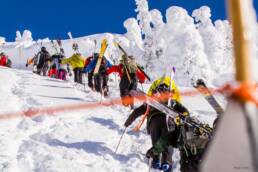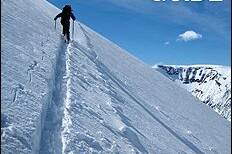
This comes from one our contributors, Mark Hartley. Mark’s written a very interesting letter to the Minister of Tourism, Sport and the Arts concerning new proposed backcountry legislation in the wake of so many recent snowmobile deaths in BC. It’s a great letter and raises some very legitimate concerns for the future of winter backcountry recreation in this province.
Dear Sir,
I read with some dismay this morning that you have proposed legislation that would impose sanctions on those who endanger the lives of others by snowmobiling above them (click here for CBC video link).
While I am not a snowmobiler, I am an avid snow sports enthusiast and I have 20 years experience learing and practicing avalanche safety. I do understand and support the concept of encouraging snow safety, but I am worried that your legislation is misguided, and also it might also be a slippery slope that this principle could be applied to other snow sports including skiing.
Exposure to avalanche hazard is a personal judgement and is the responsibility of the individual exposing themselves to be aware, and make their own decisions about acceptable risk.
A highmarker on a sled may have made a judgement about risk/reward regarding a route on a slope, and may be in a safer position in the avalanche start zone, even while acting as a trigger, than someone in the runout/deposition zone below. A person sitting in the runout of the slope should also be exercising their own judgement and, although they probably wouldnt trigger an avalanche, they are in a position of high consequence should the slope avalanche. In the case of snow machines it is not usually difficult to see or hear if there is a sled on a slope above that might trigger an avalanche, and spending much time in the runout of an avalanche path is not recommended, whether or not a trigger is being applied to the slope above.
If this legislation is passed, it could potentially set a precedent for backcountry skiers also. In contrast to snow mobiling, a skier might tend to approach a questionable slope from the top for safety reasons (accessing it via a different route), and also a skier does not produce the noise that a sled does. Thus a person on the slope below might be unaware of the skier (potential trigger) above, more so than similar situations with snow machines. Therefore it is crucial in skiing, as in snowmobiling, that exposure to overhead hazards be carefully evaluated. At many ski areas, people are able to traverse under big slopes to access a bit of powder. Other people enjoy skiing the big slopes, presenting a hazardous interaction. To blame the person above, because they act as a trigger, is to ignore the greater responsibility of the person below who is exposing themselves to the hazard. To hold a skier responsible for the poor judgement of another, just because they were a part of the hazard that the other person exposed themselves to, is ludicrous. This logic holds true for snow mobilers.
I am concerned that the legislation proposed is misguided and seems to be put together hastily without a thorough understanding of the reality of avalanche safety. It seems to me that if the government was so concerned about the safety and accountability of snowmobilers, it would introduce the legislation to ensure registration and licensing of snow machines. Such legislation is extremely tardy, as almost every other jurisdiction in North America has already enacted similar legislation. This promised legislation could include requirements for avalanche education for all sled users in mountainous terrain, which would allow users to learn that controlling exposure to hazard is a personal responsibility.
Please take back your proposed legislation and focus your efforts on promoting good judgement, rather than blaming users for the mistakes of others.
Thanks for your time and attention.
Mark Hartley
Revelstoke. BC
Mitchell Scott
Mitchell Scott is the Editor-in-Chief and co-publisher of Kootenay Mountain Culture Magazine.
Related Stories
Selkirk Wilderness A Skiers Shangri-La
Over the years the KMC team has been lucky enough to visit the utopian state of Meadow Creek, as guests of Selkirk…
How Many Backcountry Skiers Are Out There?
Over the last 20 years, the backcountry has seen a massive spike in use. From sledders to shredders, on any given…
Tyson Rettie is taking blind people backcountry skiing. This is how.
With his Braille Mountain Initiative, Tyson Rettie is introducing visually impaired skiers to the backcountry. By Ryan…
Skiing World Loses a Bright Light: Dave Treadway Perishes in Backcountry Accident
It's with heavy hearts we share the loss of legendary Canadian skier, and our bud, Dave Treadway. Rest in peace,…







